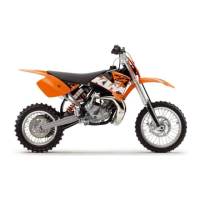15 TUNING THE ENGINE 66
15.4 Carburetor - adjusting the idle speed x
601965-10
– Screw in idle air adjusting screw 2 all the way and turn it to the specified basic
position.
Guideline
Idle air adjusting screw
Open 3.5 turns
– Run the engine until warm.
Guideline
Warm-up time ≥ 5 min
Danger
Danger of poisoning Exhaust gases are toxic and inhaling them may result
in unconsciousness and/or death.
– When running the engine, always make sure there is sufficient ventila-
tion, and do not start or run the engine in an enclosed space without an
effective exhaust extraction system.
– Adjust the idle speed with the adjusting screw 1.
Guideline
Choke function deactivated – The choke lever is pushed up all the way.
( p. 12)
Idle speed 1,400… 1,500 rpm
– Turn idle air adjusting screw 2 slowly in a clockwise direction until the idle speed
begins to fall.
– Note the position and turn the idle air adjusting screw slowly counterclockwise until
the idle speed falls again.
– Adjust to the point between these two positions with the highest idle speed.
Info
If the engine speed rises considerably, reduce the idle speed to a normal
level and repeat the above steps.
If the procedure described here does not lead to satisfactory results, the
cause may be a wrongly dimensioned idling jet.
If you can turn the idle air adjusting screw to the end without any change of
engine speed, you need to install a smaller idling jet.
After changing the idling jet, start from the beginning with the adjusting
steps.
Following extreme air temperature or altitude changes, adjust the idle speed
again.
15.5 Emptying the carburetor float chamber x
Danger
Fire hazard Fuel is highly flammable.
– Never refuel the vehicle near open flames or burning cigarettes, and always switch off the engine first. Be careful that no
fuel is spilt, especially on hot vehicle components. Clean up spilt fuel immediately.
– The fuel in the fuel tank expands when warm and may emerge if overfilled. Follow the instructions on refueling.
Warning
Danger of poisoning Fuel is poisonous and a health hazard.
– Fuel must not come into contact with the skin, eyes, or clothing. Do not breathe in the fuel vapors. If contact occurs with
the eyes, rinse with water immediately and contact a physician. Immediately clean contaminated areas on the skin with
soap and water. If fuel is swallowed, contact a physician immediately. Change clothing that is contaminated with fuel.
Store fuel properly in a suitable canister and keep away from children.
Warning
Environmental hazard Improper handling of fuel is a danger to the environment.
– Do not allow fuel to get into the ground water, the ground, or the sewage system.

